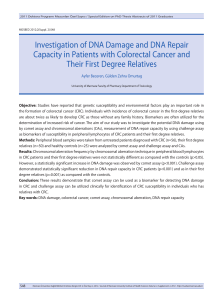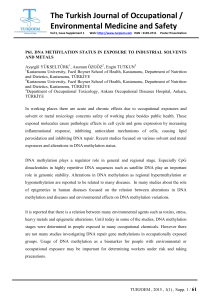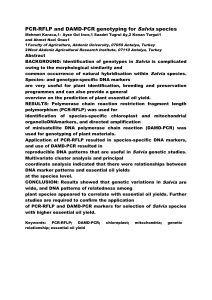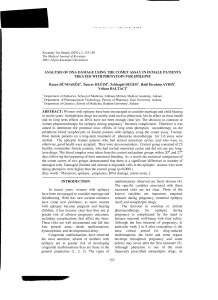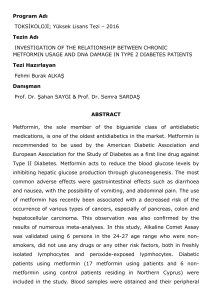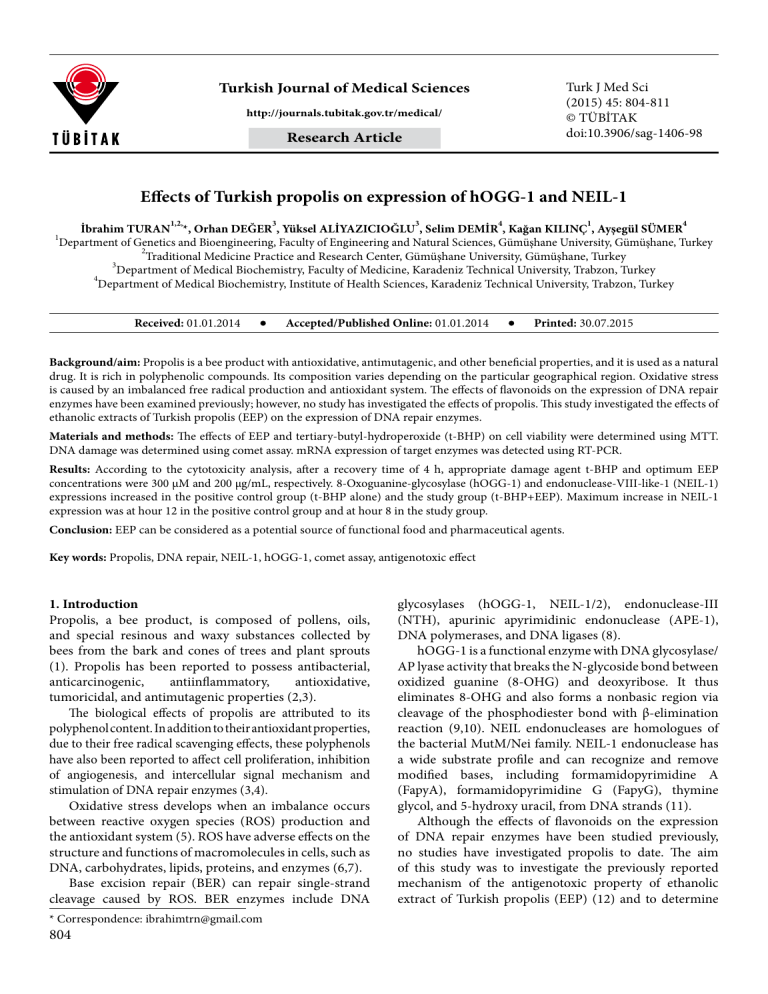
Turkish Journal of Medical Sciences
Turk J Med Sci
(2015) 45: 804-811
© TÜBİTAK
doi:10.3906/sag-1406-98
http://journals.tubitak.gov.tr/medical/
Research Article
Effects of Turkish propolis on expression of hOGG-1 and NEIL-1
1,2,
3
3
4
1
4
İbrahim TURAN *, Orhan DEĞER , Yüksel ALİYAZICIOĞLU , Selim DEMİR , Kağan KILINÇ , Ayşegül SÜMER
Department of Genetics and Bioengineering, Faculty of Engineering and Natural Sciences, Gümüşhane University, Gümüşhane, Turkey
2
Traditional Medicine Practice and Research Center, Gümüşhane University, Gümüşhane, Turkey
3
Department of Medical Biochemistry, Faculty of Medicine, Karadeniz Technical University, Trabzon, Turkey
4
Department of Medical Biochemistry, Institute of Health Sciences, Karadeniz Technical University, Trabzon, Turkey
1
Received: 01.01.2014
Accepted/Published Online: 01.01.2014
Printed: 30.07.2015
Background/aim: Propolis is a bee product with antioxidative, antimutagenic, and other beneficial properties, and it is used as a natural
drug. It is rich in polyphenolic compounds. Its composition varies depending on the particular geographical region. Oxidative stress
is caused by an imbalanced free radical production and antioxidant system. The effects of flavonoids on the expression of DNA repair
enzymes have been examined previously; however, no study has investigated the effects of propolis. This study investigated the effects of
ethanolic extracts of Turkish propolis (EEP) on the expression of DNA repair enzymes.
Materials and methods: The effects of EEP and tertiary-butyl-hydroperoxide (t-BHP) on cell viability were determined using MTT.
DNA damage was determined using comet assay. mRNA expression of target enzymes was detected using RT-PCR.
Results: According to the cytotoxicity analysis, after a recovery time of 4 h, appropriate damage agent t-BHP and optimum EEP
concentrations were 300 µM and 200 µg/mL, respectively. 8-Oxoguanine-glycosylase (hOGG-1) and endonuclease-VIII-like-1 (NEIL-1)
expressions increased in the positive control group (t-BHP alone) and the study group (t-BHP+EEP). Maximum increase in NEIL-1
expression was at hour 12 in the positive control group and at hour 8 in the study group.
Conclusion: EEP can be considered as a potential source of functional food and pharmaceutical agents.
Key words: Propolis, DNA repair, NEIL-1, hOGG-1, comet assay, antigenotoxic effect
1. Introduction
Propolis, a bee product, is composed of pollens, oils,
and special resinous and waxy substances collected by
bees from the bark and cones of trees and plant sprouts
(1). Propolis has been reported to possess antibacterial,
anticarcinogenic,
antiinflammatory,
antioxidative,
tumoricidal, and antimutagenic properties (2,3).
The biological effects of propolis are attributed to its
polyphenol content. In addition to their antioxidant properties,
due to their free radical scavenging effects, these polyphenols
have also been reported to affect cell proliferation, inhibition
of angiogenesis, and intercellular signal mechanism and
stimulation of DNA repair enzymes (3,4).
Oxidative stress develops when an imbalance occurs
between reactive oxygen species (ROS) production and
the antioxidant system (5). ROS have adverse effects on the
structure and functions of macromolecules in cells, such as
DNA, carbohydrates, lipids, proteins, and enzymes (6,7).
Base excision repair (BER) can repair single-strand
cleavage caused by ROS. BER enzymes include DNA
*Correspondence: [email protected]
804
glycosylases (hOGG-1, NEIL-1/2), endonuclease-III
(NTH), apurinic apyrimidinic endonuclease (APE-1),
DNA polymerases, and DNA ligases (8).
hOGG-1 is a functional enzyme with DNA glycosylase/
AP lyase activity that breaks the N-glycoside bond between
oxidized guanine (8-OHG) and deoxyribose. It thus
eliminates 8-OHG and also forms a nonbasic region via
cleavage of the phosphodiester bond with β-elimination
reaction (9,10). NEIL endonucleases are homologues of
the bacterial MutM/Nei family. NEIL-1 endonuclease has
a wide substrate profile and can recognize and remove
modified bases, including formamidopyrimidine A
(FapyA), formamidopyrimidine G (FapyG), thymine
glycol, and 5-hydroxy uracil, from DNA strands (11).
Although the effects of flavonoids on the expression
of DNA repair enzymes have been studied previously,
no studies have investigated propolis to date. The aim
of this study was to investigate the previously reported
mechanism of the antigenotoxic property of ethanolic
extract of Turkish propolis (EEP) (12) and to determine
TURAN et al. / Turk J Med Sci
whether or not this is due to induction of BER pathway
enzymes.
2. Materials and methods
2.1. Chemicals
Propolis samples were produced by honey bees (Apis
mellifera L.) in Trabzon, Turkey. Foreskin fibroblast cells
(CRL-2522) were obtained from the American Type
Culture Collection (ATCC, Manassas, VA, USA). Ethanol
and NaCl were purchased from Merck (Darmstadt,
Germany). Dimethyl sulfoxide (DMSO) was purchased
from Carlo Erba (Milan, Italy), penicillin-streptomycin
and trypsin from GIBCO (Paisley, UK), Dulbecco’s
modified eagle medium (DMEM) from Lonza (Verviers,
Belgium), fetal bovine serum (FBS) and polylysine from
Biochrom (Berlin, Germany), phosphate buffer saline
(PBS) tablet from Medicago (Uppsala, Sweden), sodium
hydroxide from Riedal De Haen (Seelze, Germany), and
RNA isolation and real-time PCR kits from QIAGEN
(Hilden, Germany). All other chemicals were purchased
from Sigma (St. Louis, MO, USA).
2.2. Extraction of propolis
First, 0.5 g of propolis was dissolved in 20 mL of ethanol.
Following vortexing, this was incubated at 60 °C and 150
rpm for 24 h. Following incubation, the propolis was
centrifuged at 4000 rpm for 10 min. Supernatants were
filtered through filter paper and 0.22-µm filters, and 25 ×
103 µg/mL stock EEP was used for experiments.
2.3. Cell culture
Fibroblast cells were cultured in DMEM containing
L-glutamine, 10% FBS, and 1% penicillin and streptomycin
in T-25 and T-75 flasks. This was accompanied by a 5%
CO2 supply at 37 °C in an incubator. Cells were passaged
when they had attained 70%–80% growth in flasks.
2.4. Cell viability
Fibroblast cells were cultured in 96-well plates at 5000
cells per well. After 24 h, the medium was removed and
the cells were treated with different concentrations of
tertiary-butyl-hydroperoxide (t-BHP; 100–600 µM) and
EEP (50–250 µg/mL). Following a 24-h incubation, 190
µL of DMEM and 10 µL of 3-(4,5-dimethylthiazol-2-yl)2,5-diphenyl tetrazolium bromide (MTT) dye with a final
concentration of 0.25 mg/mL were added to the wells. After
a 2-h incubation, the well content was removed and 200 µL
of DMSO was added to all wells, which were incubated for
30 min. Absorbance of the wells was read at 570 nm using
a microplate reader (Molecular Devices, Sunnyvale, CA,
USA). The results were calculated on the basis of control
samples (cells without any test compound).
2.5. Determination of t-BHP concentration
A total of 2 × 105 fibroblast cells were cultured in a flask.
After 24 h, cells were treated with 100–600 µM t-BHP for 1
h to determine the concentration resulting in DNA damage
but not toxicity. After incubation, cells were washed with
PBS and left to recover for 4 h. Cells were trypsinized and
centrifuged for comet assay.
2.6. Determination of EEP concentration
EEP with final concentrations of 100, 150, and 200 µg/mL
was added to the cells to determine the concentration that
would prevent DNA damage without toxicity. Ethanol was
used for a negative control (0 concentration). After 1 h,
flasks were washed with PBS, and cells were treated with
300 µM t-BHP for another hour. Following incubation,
flasks were washed and left for a recovery time of 4, 8, 12,
or 24 h. Cells were trypsinized and centrifuged for comet
protocol and RNA isolation.
2.7. Comet assay
A total of 40 μL of cell suspension was mixed with 80 μL of
low melting point agarose in a polypropylene tube, spread
on a slide coated with polylysine and normal melting point
agarose, closed with a coverslip, and incubated at 4 °C for
5 min. Coverslips were removed and cells were incubated
in lysis buffer for 1 h. Cells were then treated in an alkaline
buffer (10 mM EDTA, 0.3 M NaOH, pH 13.1) for 30 min.
Cells were held in 22 V (1 V/cm), 300 mA electrophoresis
conditions for 20 min. After electrophoresis, cells were
neutralized in buffer (Tris, pH 7.4) and incubated in
ethidium bromide for 20 min. Cells were evaluated in
an Eclipse E800 fluorescence microscope (Nikon, Tokyo,
Japan) by filters (G-2A, excitation 510–565 nm, DM 575,
BA 590) at 40× magnification. Visual analysis was used for
scoring. Three slides were prepared for each group. One
hundred cells from each of the slides were scored for DNA
damage. Slide scoring was performed on a blind basis
with the scorer blind to the treatment conditions of each
slide. Selected cells were classified between 0 and 3, from
nondamaged to most damaged, according to tail length.
Excessively long tails and DNA spectra scored at 4 were
not included (12).
All slides were scored with the following formula with
a maximum damage possibility of 300:
Score = (1 × n1) + (2 × n2) + (3 × n3) (n: cell number
for every score) (13).
2.8. RNA isolation
Total RNA isolation kits (QIAGEN RNeasy) were used
for RNA isolation from the cells. Purity of RNAs was
determined with NanoDrop (Thermo Scientific, Waltham,
MA, USA) by measuring the OD260/OD280 ratio.
2.9. mRNA expression analysis
β-Actin primers for forward 5’-TCA CCC AAC ACT
GTG CCC ATC TAC GA-3’ and for reverse 5’-TCG GTG
AGG ATC TTC ATG AGG TA-3’ were used as a reference,
producing a 180-bp fragment (14). Specific primer pairs
for NEIL-1 (forward: 5’-CGG CGG CTG CGT GGA GAA
805
TURAN et al. / Turk J Med Sci
GTC-3’; reverse: 5’-GTC CCA GCG GCC GAA CCG
GCG-3’) and hOGG-1 (forward: 5’-AAC AAC AAC ATC
GCC CGC ATC ACT-3’; reverse: 5’-GCT AGC CCG CCC
TGT TCT TCC-3’) were previously described by Das et al.
(15) and Collins et al. (16). Primers were manufactured by
Metabion International AG (Martinsried, Germany).
Expression analysis was performed with a Roche Light
Cycler 480-II (Rotkreuz, Switzerland) using the SYBR
Green method. Complementary DNA was amplified in
a 15-µL total volume containing SYBR Green master
mix and 7.5 µM of specific primers. Real time-PCR was
performed through amplification for 45 cycles of 94 °C (15
s), 50 °C (30 s), and 72 °C (30 s) after enzyme activation at
95 °C (15 min). Results were calculated with basic relative
quantification according to β-actin expression of negative
control samples (cells without any test compound).
2.10. Statistical analysis
All experiments were carried out in triplicate. All results
are given as mean ± standard deviation (SD). Compatibility
with normal distribution was determined using the
Kolmogorov–Smirnov test. One-way ANOVA was used
for comparing differences among the groups. P < 0.05 was
regarded as significant.
120
100
80
60
40
20
0
0
50
100
150
200
EEP concentration (µg/mL)
250
300
Figure 1. Effect of EEP on fibroblast cell viability shown by the
MTT reduction test. Fibroblast cells were incubated for 24 h with
increasing concentrations of EEP. Control cells were incubated in
the presence of 1% ethanol. Values represent mean ± SD based on
results obtained in at least 3 independent experiments.
806
3.3. NEIL-1 and hOGG-1 mRNA expressions results
The two main glycosylase enzymes in the BER pathway
(hOGG-1 and NEIL-1) were investigated. The mRNA
levels for each enzyme were compared with control cells
that were not exposed to oxidative stress with t-BHP.
NEIL-1 mRNA expression slightly increased 1.5- and
2.7-fold after 8 h, and 1.2- and 5.5-fold after 12 h, with
or without EEP treatment. After 24 h, it returned to levels
below baseline in the EEP treatment group only (Figure 4).
hOGG-1 mRNA expression increased 1.18-, 1.43-,
and 1.5-fold after 4, 8, and 12 h, respectively, with t-BHP
treatment alone compared with the negative control.
hOGG-1 mRNA expression only increased 1.3-fold after
12 h in the EEP and t-BHP treatment groups (Figure 5).
4. Discussion
Molecular studies of Turkish propolis are limited in number.
In a recent study, Aliyazicioglu et al. were the first to report
the antigenotoxic activity of propolis by demonstrating
that EEP reduced H2O2-induced DNA damage (12). The
aim of the present study was to investigate the origin of
the antigenotoxic activity of EEP. Was it induction of DNA
repair enzyme expression, or not? We established that
100–200 µg/mL EEP significantly reduced 300 µM t-BHPinduced DNA damage. Similar studies have demonstrated
that different propolis extracts from various countries also
reduce DNA damage (2,12,13,17,18). hOGG-1 and NEIL1 expression levels increased significantly according to the
expression analysis with mRNA samples of EEP-treated
cells.
Cell proliferation (% of control)
Cell proliferation (% of control)
3. Results
3.1. Cell viability
EEP was found to be nontoxic between concentrations
of 50 and 200 µg/mL in cell viability analysis (Figure 1).
t-BHP was found to be nontoxic between concentrations
of 0 and 600 µM in cell viability analysis (Figure 2).
3.2. Comet analysis
t-BHP of 300 µM, which produces a 300 comet score in 4
h, was used as the damage concentration in all assays. Cells
were pretreated with EEP (3 different concentrations) for
1 h. Comet scores were compared after damage with 300
µM t-BHP (Figure 3). There was no significant difference
between hours in group A (P > 0.05), although there was a
significant difference in group B (P < 0.0001). In groups C,
D, and E there was a significant difference between hours
12 and 24 (P < 0.0001), but no significant difference was
noted between other hours (P > 0.05). EEP concentration
for expression analysis was determined at 200 µg/mL.
120
100
80
60
40
20
0
0
100
200
300
400
500
t-BHP concentration (µM)
600
700
Figure 2. Effect of t-BHP on fibroblast cell viability based on the
MTT reduction test. Fibroblast cells were incubated for 24 h with
increasing concentrations of t-BHP. Control cells were incubated
in the presence of 1% PBS. Values represent mean ± SD based on
the results obtained in at least 3 independent experiments.
TURAN et al. / Turk J Med Sci
350
DNA damage (AU)
300
250
200
150
100
50
0
7
*
6
5
"
4
*
NEIL-1 expression (fold-change relative to control)
Figure 3. Effect of 1-h pretreatment of EEP (100, 150, and 200 µg/mL) on t-BHP (300 µM, 1 h)induced DNA damage in fibroblast cells with 4, 8, 12, and 24-h recovery periods. DNA damage
was assessed using comet assay. Comets were quantified by visual analysis, and values were
calculated using the formula described in Section 2.7. Bars represent mean ± SD for at least 3
independent experiments.
3
2
1
*
*
*
*
*
*
0
Figure 4. Relative mRNA levels of NEIL-1 under oxidant challenge. Fibroblast cells were
pretreated with EEP (200 µg/mL, 1 h) after incubation with t-BHP (300 µM, 1 h)-induced
DNA damage with 4, 8, 12, and 24-h recovery periods. Relative mRNA level of NEIL-1
versus β-actin was determined using RT-PCR. Each bar represents the mean ± SD for at
least 3 independent experiments. *: P < 0.05 compared to negative control cells (with no
treatment).
Antigenotoxic and antimutagenic activities of propolis
have been reported in several in vivo and in vitro studies.
Munari et al. demonstrated the protective effect of
ethyl acetate extracts of Baccharis dracunculifolia, one
of the major botanical sources of propolis, on methyl
methanesulfonate (MMS)-induced DNA damage in V79
cell lines with simultaneous treatment and posttreatment.
They suggested that this action could be attributed to the
free radical scavenging and inducing expression of the
DNA repair enzyme activities of the polyphenolic content
of Baccharis dracunculifolia (13).
In another study, Chen et al. investigated the effects of
baicalin, a flavonoid isolated from the roots of Scutellaria
baicalensis, on H2O2-induced DNA damage in NIH3T3
807
hOGG-1 expression
(fold-change
relave to control)
TURAN et al. / Turk J Med Sci
1.8
1.6
1.4
1.2
1
0.8
0.6
0.4
0.2
0
*
*
*
*
*
*
*
*
Figure 5. Relative mRNA levels of OGG-1 under oxidant challenge. Fibroblast cells were
pretreated with EEP (200 µg/mL, 1 h) after incubation with t-BHP (300 µM, 1 h)-induced
DNA damage with 4, 8, 12, and 24-h recovery periods. Relative mRNA level of OGG-1
versus β-actin was determined using RT-PCR. Each bar represents the mean ± SD for at
least 3 independent experiments. *: P < 0.05 compared to negative control cells (with no
treatment).
cell lines. They reported that DNA damage decreased
significantly in a group of cells pretreated with baicalin
for 24 h and damaged with H2O2 for 15 min compared to
a damaged control group. They suggested that this might
derive from stimulation of the DNA repair mechanism in
addition to the antioxidant activity of baicalin (19).
MMS, H2O2, ferrous sulfate, t-BHP, and doxorubicine
have been reported to cause in vitro DNA damage in cells
in antigenotoxicity studies (4,13,19,20). In this study,
t-BHP was used to damage DNA in fibroblasts. t-BHP
has been used to determine the cellular injury mechanism
caused by acute oxidative stress (20). t-BHP is an organic
hydroperoxide that forms alkali-labile regions and singlestrand cleavage, causing oxidative DNA damage. DNA
damage caused in this way can easily be determined using
comet assay analysis (20,21). In this study, comet analysis
was used to measure DNA damage due to its advantages
over other methods, such as simplicity, economy,
sensitivity, reliability, and speed (22,23).
In this study, comet scoring was performed using
a scale of 0 (no damage) to 3 (most damage) in visual
analysis in the comet assay between 100 and 600 μM t-BHP
damaging concentrations. Maximum comet score would
be 300 on this scale, and the t-BHP concentration was
therefore selected as 300 μM. MTT analysis cell viability
was compatible with the literature (20,24–27).
Comet analysis of cells carried out with 100, 150,
and 200 µg/mL EEP and damaged with 300 µM t-BHP
demonstrated that the highest antigenotoxic concentration
was 200 µg/mL. This concentration also applied to cell
viability and was therefore selected for use in expression
analysis.
Cells are known to activate the BER pathway in
oxidative base damage. BER mechanism enzyme NEIL1 and hOGG-1 expressions were measured with relative
808
quantitation at recovery times of 4, 8, 12, and 24 h. hOGG1 mRNA expression increased in the positive control group
as well as in the study group. Maximum expression levels
in both groups were obtained at hour 12. At the end of
hour 24, expression levels decreased below basal levels in
the study group and remained at basal levels in the positive
control group.
Gao et al. suggested that flavonoid naringenin prevents
ferrous sulfate-induced DNA damage in LNCaP cell lines
by inducing expression of 8-oxoguanine-DNA-glycosylase
and DNA polymerase, enzymes involved in the BER
mechanism. Those results differ from our study in that
the highest expression level was determined at hour 8.
At the end of hour 24, expressions were reported to have
increased in the assay group and to have returned to basal
levels in the positive control group (4). These differences
may be due to the use of a different cell type, damage agent,
and one type of flavonoid. The authors also reported that
although LNCaP cell lines are resistant to oxidative stress,
they have low repair capacity. In our study, total damage
was eliminated in 24 h. This may be the result of a wide
range of flavonoid contents in propolis, rather than a single
flavonoid, and may derive from those flavonoids exhibiting
a synergistic effect. Erdogan et al. investigated the content
of Anatolian propolis, describing it as rich in phenolic
compounds such as caffeic acid, gallic acid, p-coumaric
acid, chlorogenic acid, myricetin, catechin, and luteolin
(28). The solubility of Turkish propolis in different solvents
was investigated by Çakıroğlu, who found that ethanolic
extracts of Turkish propolis had high antioxidant capacity
and were rich in quercetin (29).
Silva et al. observed the effects of luteolin, quercetin,
and rosmarinic acid on t-BHP and light-sensitive
compound Ro19-8022-induced DNA damage in PC12
cell lines. They observed that luteolin and quercetin
TURAN et al. / Turk J Med Sci
radical induced DNA repair enzyme hOGG-1 expression
and prevented DNA damage through radical scavenging
activity and rosmarinic acid via a direct effect. However,
they reported that mRNA levels were unable to exceed
negative control expression levels. Similarly, in our study,
hOGG-1 expression at hour 4 was lower compared to the
negative control group. This may be explained in terms of
the dynamic equilibrium of oxidative DNA damage. This
theory suggests that basic DNA damage forming in the
presence of EEP may be less than in the absence of EEP.
Oxidized base formation is an expected phenomenon,
so DNA repair enzyme levels were not expressed in the
negative control group (25).
Min et al. observed possible mechanisms of quercetin
in protecting cells against H2O2-induced DNA damage in
Caco-2 cell lines and reported that quercetin enhances
DNA repair via radical scavenging and by inducing
hOGG-1 expression (14). In contrast to our study,
maximum hOGG-1 mRNA levels were seen at hour 4,
dropped below basal levels at hour 8, and reached basal
levels again at hour 12. The results of the 1-µM quercetintreated group were similar to those of the positive control
group, although the peak at hour 4 was not seen in this
group, and this difference was not discussed. Maximum
hOGG-1 levels in the 100-µM quercetin-treated group
were obtained at hour 4 and gradually decreased to basal
levels at the end of hour 12. These differences may be due
to cell and damaging compound type and the use of a
single flavonoid in the study.
NEIL-1 mRNA expressions were higher both in the
study group and in the positive control group. Peaks in
the positive control and study groups were seen at hours
8 and 12, respectively. In the study group, enzyme levels
decreased below basal expression levels at the end of hour
24 and remained at basal levels in the positive control
group. The effects of natural products on NEIL-1 mRNA
expression levels have not been investigated before, and
this is the first report in this field. Das et al. reported that
hydrogen peroxide produced by glucose oxidase enhanced
NEIL-1 mRNA and polypeptide levels 2- to 4-fold 6 h
after treatment in HCT 116 cells. They interpreted this
as a result of the transactivation of the NEIL-1 promoter
region by ROS (15). The increases in NEIL-1 expression
that started at hour 4 and persisted until hour 12 are
therefore compatible with previous studies. EEP did not
enhance expression in this group. This may be attributed
to low DNA damage. High NEIL-1 expression compared
to hOGG-1 in the t-BHP group may be due to the wide
oxidized base substrate specificity of NEIL-1 or to
the location of the damaged bases in the DNA strand
(15,30,31).
Evaluation of comet scores indicated that EEP was
quite effective in preventing DNA damage, and t-BHPinduced damage was mostly eliminated after 4 h of
recovery. This antigenotoxic action may be the result of
a positive effect of propolis on the antioxidant system at
both activity and expression levels in a recovery time of 4
h, rather than the result of induction of the BER pathway
enzymes, hOGG-1, and NEIL-1. It is also possible that
pretreatment of EEP causes chelation of metal ions so that
t-BHP application does not give rise to advanced Fenton
reaction and DNA damage. At low concentrations, EEP
protects cells from harmful chemical effects, but it is
mutagenic at high concentrations. This may be ascribed
to the Janus compound characteristics of propolis. This is
provided by both enzyme induction in the antimutagenic
system and saturation of enzyme systems in the DNA
repair mechanism. Flavonoids in EEP are assessed as
Janus compounds. Depending on their concentrations,
they act as prooxidants or radical scavengers and exhibit
mutagenic or antimutagenic activity (2,32,33). De Flora
suggested that biopolyphenols exhibit antimutagenic or
anticarcinogenic effects not only by scavenging radicals
but also by chelating transition metals and inhibiting
radical formation (34).
Additionally, increased NEIL-1 and hOGG-1
expressions in EEP-treated cells may be due to these vital
DNA repair enzymes being tightly regulated. Small changes
in the expression of these genes with toxic or nontoxic
stimulants support this theory (25). Furthermore, if DNA
damage has occurred in cells, the DNA damage checkpoint
should be activated to arrest cell cycle progression until
DNA is repaired (35). Additionally, the reactions of DNA
repair systems are dependent on the use of ATP (36). In
light of this information, EEP may play a pivotal role by
decreasing ATP consumption in cells or preventing cell
cycle arrest.
In conclusion, based on the comet assay results, the
antigenotoxic effect of EEP may be attributed to preventing
oxidative damage through radical scavenging, metal
chelating, or modulation of antioxidant response, rather
than increasing expression of DNA repair enzymes. EEP
can be considered as a potential source of functional food
and as a pharmaceutical agent.
Acknowledgment
This study was supported by the Foundation of Scientific
Research of Karadeniz Technical University, Trabzon,
Turkey (Nos. 2007.114.001.3 and 2008.114.001.5).
809
TURAN et al. / Turk J Med Sci
References
1. Tosi B, Donini A, Romagnoli C, Bruni A. Antimicrobial
activity of some commercial extracts of propolis prepared with
different solvents. Phytother Res 1996; 10: 335–336.
16. Collins AR, Harrington V, Drew J, Melvin R. Nutritional
modulation of DNA repair in a human intervention study.
Carcinogenesis 2003; 24: 511–515.
2. Pereira AD, Andrade SF, Oliveira Swerts MS, Maistro EL. First
in vivo evaluation of the mutagenic effect of Brazilian green
propolis by comet assay and micronucleus test. Food Chem
Toxicol 2008; 46: 2580–2584.
17. Benković V, Orsolić N, Knezević A, Ramić S, Dikić D, Basić I,
Kopjar N. Evaluation of the radioprotective effects of propolis
and flavonoids in gamma-irradiated mice: the alkaline comet
assay study. Biol Pharm Bull 2008; 31: 167–172.
3. Barlak Y, Değer O, Çolak M, Karataylı SC, Bozdayı AM,
Yücesan F. Effect of Turkish propolis extracts on proteome of
prostate cancer cell line. Proteome Sci 2011; 9: 74–85.
18. Tavares DC, Barcelos GRM, Silva LF, Tonin CCC, Bastos JK.
Propolis-induced genotoxicity and antigenotoxicity in Chinese
hamster ovary cells. Toxicol In Vitro 2006; 20: 1154–1158.
4. Gao K, Henning SM, Niu Y, Youssefian AA, Seeram NP, Xu
A, Heber D. The citrus flavonoid naringenin stimulates DNA
repair in prostate cancer cells. J Nutr Biochem 2006; 17: 89–95.
19. Chen X, Nishida H, Konishi T. Baicalin promoted the repair
of DNA single strand breakage caused by H2O2 in cultured
NIH3T3 fibroblasts. Biol Pharm Bull 2003; 26: 282–284.
5. Ramos AA, Azqueta A, Pereira-Wilson C, Collins AR.
Polyphenolic compounds from Salvia species protect cellular
DNA from oxidation and stimulate DNA repair in cultured
human cells. J Agr Food Chem 2010; 58: 7465–7471.
20. Lee KJ, Choi JH, Hwang YP, Chung YC, Jeong HG.
Protective effect of caffeic acid phenethyl ester on tert-butyl
hydroperoxide-induced oxidative hepatotoxicity and DNA
damage. Food Chem Toxicol 2008; 46: 2445–2450.
6. Halliwell B. Oxidants and human disease: some new concepts.
FASEB J 1987; 1: 358–364.
21. Smart RC, Hodgson E. Molecular and Biochemical Toxicology.
4th ed. Hoboken, NJ, USA: Wiley; 2008.
7. Dinçer Y, Akçay T. DNA Damage. Turk J Biochem 2000; 25:
73–79.
8. Berquist BR, Wilson DM. Pathways for repairing and tolerating
the spectrum of oxidative DNA lesions. Cancer Lett 2012; 327:
61–72.
22. Collins AR, Dobson VL, Dusinská M, Kennedy G, Stětina R.
The comet assay: what can it really tell us? Mutat Res 1997; 375:
183–193.
9. Radicella JP, Dherin C, Desmaze C, Fox MS, Boiteux S.
Cloning and characterization of hOGG1, a human homolog of
the OGG1 gene of Saccharomyces cerevisiae. P Natl Acad Sci
USA 1997; 94: 8010–8015.
10. Hirano T. Repair system of 7,8-dihydro-8-oxoguanine as a
defense line against carcinogenesis. J Radiat Res 2008; 49: 329–
340.
11. Dou H, Mitra S, Hazra TK. Repair of oxidized bases in DNA
bubble structures by human DNA glycosylases NEIL1 and
NEIL2. J Biol Chem 2003; 278: 49679–49684.
12. Aliyazicioglu Y, Demir S, Turan I, Cakiroglu TN, Akalin I,
Deger O, Bedir A. Preventive and protective effects of Turkish
propolis on H2O2-induced DNA damage in foreskin fibroblast
cell lines. Acta Biol Hung 2011; 62: 388–396.
13. Munari CC, Alves JM, Bastos JK, Tavares DC. Evaluation
of the genotoxic and antigenotoxic potential of Baccharis
dracunculifolia extract on V79 cells by the comet assay. J Appl
Toxicol 2009; 30: 22–28.
14. Min K, Ebeler SE. Quercetin inhibits hydrogen peroxideinduced DNA damage and enhances DNA repair in Caco-2
cells. Food Chem Toxicol 2009; 47: 2716–2722.
15. Das A, Hazra TK, Boldogh I, Mitra S, Bhakat KK. Induction of
the human oxidized base-specific DNA glycosylase NEIL1 by
reactive oxygen species. J Biol Chem 2005; 280: 35272–35280.
810
23. Hartmann A, Agurell A, Beevers C, Brendler-Schwaab S,
Burlinson B, Clay P, Collins A, Smith A, Speit G, Thybaud V
et al. Recommendations for conducting the in vivo alkaline
comet assay. Mutagenesis 2003; 18: 45–51.
24. Ramos AA, Lima CF, Pereira ML, Fernandes-Ferreira M,
Pereira-Wilson C. Antigenotoxic effects of quercetin, rutin
and ursolic acid on HepG2 cells: evaluation by the comet assay.
Toxicol Lett 2008; 177: 66–73.
25. Silva JP, Gomes AC, Coutinho OP. Oxidative DNA damage
protection and repair by polyphenolic compounds in PC12
cells. Eur J Pharmacol 2008; 601: 50–60.
26. Maher P, Hanneken A. Flavonoids protect retinal ganglion
cells from oxidative stress-induced death. Invest Ophth Vis Sci
2005; 46: 4796–4803.
27. Huang Q, Wu LJ, Tashiro S, Gao HY, Onodera S, Ikejima T.
(+)-Catechin, an ingredient of green tea, protects murine
microglia from oxidative stress-induced DNA damage and cell
cycle arrest. J Pharmacol Sci 2005; 98: 16–24.
28. Erdogan S, Ates B, Durmaz G, Yilmaz I, Seckin T. Pressurized
liquid extraction of phenolic compounds from Anatolia
propolis and their radical scavenging capacities. Food Chem
Toxicol 2011; 49: 1592–1597.
29. Çakıroğlu TN. Investigation of solubility of Turkish propolis
in different solvents. MSc, Karadeniz Technical University,
Trabzon, Turkey, 2010.
30. Parsons JL, Zharkov DO, Dianov GL. NEIL1 excises 3’ end
proximal oxidative DNA lesions resistant to cleavage by NTH1
and OGG1. Nucleic Acids Res 2005; 33: 4849–4856.
TURAN et al. / Turk J Med Sci
31. Parsons JL, Kavli B, Slupphaug G, Dianov GL. NEIL1 is the
major DNA glycosylase that processes 5-hydroxyuracil in the
proximity of a DNA single-strand break. Biochemistry 2007;
46: 4158–4163.
34. De Flora S. Mechanisms of inhibitors of mutagenesis and
carcinogenesis. Mutat Res 1998; 402: 151–158.
32. Von Borstel RC, Higgins JA. Janus carcinogens and mutagens.
Mutat Res 1998; 402: 321–329.
36. Hogan C, Varga-Weisz P. The regulation of ATP-dependent
nucleosome remodelling factors. Mutat Res 2007; 618: 41–51.
33. Munari CC, Resende FA, Alves JM, De Sousa JP, Bastos JK,
Tavares DC. Mutagenicity and antimutagenicity of Baccharis
dracunculifolia extract in chromosomal aberration assays in
Chinese hamster ovary cells. Planta Med 2008; 74: 1363–1367.
35. Peng A. Working hard for recovery: mitotic kinases in the
DNA damage checkpoint. Cell Biosci 2013; 3: 1–8.
811





